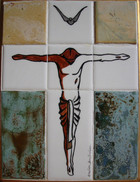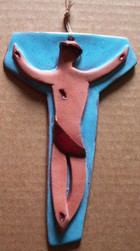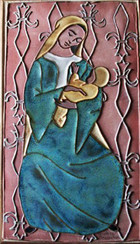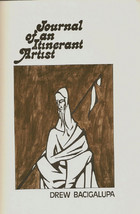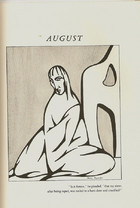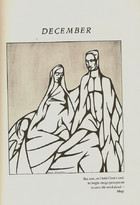Andrea Bacigalupa
(1923-2015)
For sacred art pilgrims, exploring the galleries on Canyon Road in Santa Fe, New Mexico, the Studio of Gian Andrea always offered a welcome place to rest sore feet and weary souls. By the time I reached this modest little gallery on my first tour of the local art scene, I had already seen my fill of faux-impressionist Western landscapes, Spanish-Colonial-styled sideboards, Native American woven blankets, and tubular abstract sculptures, and was delighted to discover a space given over to contemporary religious art.
When I entered, the owner, Andrea Bacigalupa, was bent over a little sculpture of St. Francis and a prairie dog, a copy of a full-sized piece by him on the lawn in front of Santa Fe’s Town Hall. Since tourists often turned tail and ran at the sight of the crucifixes and Madonnas inside, Bacigalupa was happy to take a break and talk with me about his work and all the changes he has seen in this, now, trendy neighborhood, since he opened his gallery some forty years ago.
Bacigalupa was not only a gifted artist but a splendid raconteur and author of ten books of fiction and memoirs, which he also illustrated. As Andrea (or “Drew”) told the story, he did not set out to be a liturgical artist. A World War II veteran, he had just graduated from the Maryland Institute College of Art and needed money to take further courses in Florence, Italy, when an old army buddy offered him a commission he could not afford to pass up--painting two altarpieces for a Roman Catholic church in Cokesville, Pennsylvania.
This set the pattern for his life. When Bacigalupa moved with his family to New Mexico, he was drawn to the region’s rich tradition of religious art. Inspired by Dominican Father Blase Schauer’s principles of “sacred environment,“ he created cutting-edge liturgical designs in keeping with Second Vatican Council reforms for church interiors in Kansas, Nebraska, Texas, Colorado, and New Mexico.
During his years making art-by-church-committee, Bacigalupa often sought solace in the notebooks of Michelangelo (another beleaguered ecclesiastical designer!) but came away strengthened in his conviction that art made for God’s glory should not be saccharine, sentimental, or stereotyped.
There is a spare dignity in the works by Andrea in the Sacred Art Pilgrim Collection. The ceramic pieces are an off-shoot of one of Bacigalupa’s first projects in his Santa Fe studio, a cycle of hand-crafted tile portraits of 50 patron saints. The illustrations come from twelve chapter headings (for the months of the year) in his memoir, The Journal of an Itinerant Artist. Looking at these glazed and mat tiles in rose, turquoise, gold and carmine, and the sinuous, molded line work of the book drawings, I see something in them of the starkly beautiful, weathered landscape of New Mexico--a place, which, for Bacigalupa, truly became God’s Country.
